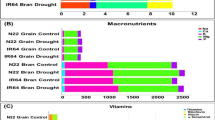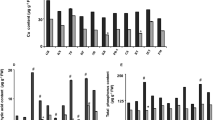Abstract
Nutritional composition is the main consideration in the safety assessment of foods derived from genetically modified (GM) crops. In this study, the key nutrients in drought-tolerant rice that had been generated by the insertion of AtCYP78A7 encoding cytochrome P450 protein were analyzed. Results were compared with those obtained from its non-transgenic counterpart and other commercial rice. When transgenic rice lines 10B-5 and 18A-4 were compared with the non-transgenic counterpart, no significant differences were found in their contents of proximates, amino acids, fatty acids, minerals, and vitamins. Except for fiber contents and levels of vitamin B2, most of the measured values fit within the reference ranges established for other commercial rice. These results indicate that the key nutritional composition of drought-tolerant transgenic rice is substantially equivalent to its non-transgenic counterpart. Therefore, insertion of AtCYP78A7 to improve drought tolerance does not change the constitution and quality of key nutrients in brown rice.
Similar content being viewed by others
References
US Department of Agriculture (USDA). World agricultural supply and demand estimates, WASDE-505. Available from: http://www.usda.gov/oce/commodity/wasde/latest.pdf. Accessed May 1, 2012.
Bray EA. Plant responses to water deficit. Trends Plant Sci. 2:48–54 (1997)
James C. Global Status of Commercialized Biotech/GM Crops: 2011. ISAAA Brief No. 43. The International Service for the Acquisition of Agri-biotech Applications (ISAAA), Ithaca, NY, USA. pp. 1–36 (2011)
Organization for Economic Co-operation and Development (OECD). Safety Evaluation of Foods Derived by Modern Biotechnology, Concepts and Principles. OECD, Paris, France. pp. 1–77 (1993)
Food and Agriculture Organization of the United Nations/World Health Organization (FAO/WHO). Safety Aspects of Genetically Modified Foods of Plant Origin. Report of a Joint FAO/WHO Expert Consultation on Foods Derived from Biotechnology. World Health Organization, Geneva, Switzerland. pp. 1–37 (2000)
Oberdoerfer RB, Shillito RD, de Beuckeleer M, Mitten DH. Rice (Oryza sativa L.) containing the bar gene is compositionally equivalent to the nontransgenic counterpart. J. Agr. Food Chem. 53: 1457–1465 (2005)
Xin L, Xiaoyun H, Yunbo L, Guoying X, Xianbin J, Kunlun H. Comparative analysis of nutritional composition between herbicidetolerant rice with bar gene and its non-transgenic counterpart. J. Food Compos. Anal. 21: 535–539 (2008)
Park SY, Lee SM, Lee JH, Ko HS, Kwon SJ, Suh SC, Shin KS, Kim JK. Compositional comparative analysis between insectresistant rice (Oryza sativa L.) with a synthetic cry1Ac gene and its non-transgenic counterpart. Plant Biotechnol. Rep. 6: 29–37 (2012)
Kasuga M, Liu Q, Miura S, Yamaguchi S, Shinozaki K. Improving plant drought, salt, and freezing tolerance by gene transfer of a single stress-inducible transcription factor. Nat. Biotechnol. 17: 287–291 (1999)
Miki B, Abdeen A, Manabe Y, MacDonald P. Selectable marker genes and unintended changes to the plant transcriptome. Plant Biotechnol. J. 7: 211–218 (2009)
Kim HB, Choi SB. Cytochrome P450 gene for increasing seed size or water stress resistance of plant. U.S. Patent 8,153,862 B2 (2012)
AOAC. Official Methods of Analysis of AOAC Intl. 17th ed. Method 930.15. Association of Official Analytical Communities, Gaithersburg, MD, USA (2000)
AOAC. Official Methods of Analysis of AOAC Intl. 18th ed. Method 984.13. Association of Official Analytical Communities, Gaithersburg, MD, USA (2006)
AOAC. Official Methods of Analysis of AOAC Intl. 18th ed. Method 920.39. Association of Official Analytical Chemists, Gaithersburg, MD, USA (2006)
AOAC. Official Methods of Analysis of AOAC Intl. 18th ed. Method 923.03. Association of Official Analytical Communities, Gaithersburg, MD, USA (2005)
AOAC. Official Methods of Analysis of AOAC Intl. 18th ed. Method 978.10. Association of Official Analytical Communities, Gaithersburg, MD, USA (2006)
AOAC. Official Methods of Analysis of AOAC Intl. 18th ed. Method 982.30. Association of Official Analytical Communities, Gaithersburg, MD, USA (2005)
Ministry of Food and Drug Safety (MFDS). Korean Food Code. MFDS, Cheongwon, Korea. pp. 10,1,40–10,1,49 (2013)
AOAC. Official Methods of Analysis of AOAC Intl. 17th ed. Method 999.11. Association of Official Analytical Communities, Gaithersburg, MD, USA (2000)
Martins-Junior HA, Wang AY, Alabourda J, Pires MAF, Vega OB, Lebre DT. A validated method to quantify folic acid in wheat flour samples using liquid chromatography-tandem mass spectrometry. J. Brazil. Chem. Soc. 19: 971–977 (2008)
Ministry of Food and Drug Safety (MFDS). Korean Food Code. MFDS, Cheongwon, Korea. pp. 10,1,86–10,1,90 (2013)
Organization for Economic Co-operation and Development (OECD). Environment, health and safety publications series on the safety of novel foods and feeds. No. 10. Consensus Document on Compositional Considerations for New Varieties of Rice (Oryza sativa): Key Food and Feed Nutrients and Anti-Nutrients. OECD, Paris, France. pp. 1–38 (2004)
Rural Development Administration (RDA). Food Composition Table. 7th ed. RDA, Suwon, Korea. pp. 17–55 (2006)
US Department of Agriculture (USDA). Nutrient database for standard reference. Available from: http://www.ars.usda.gov/Services/docs.htm?docid=8964. Accessed May 1. 2012.
Ministry of Education, Culture, Sports, Science and Technology (MEXT). Food composition database, 2010. Available from: http://fooddb.jp/. Accessed May 1. 2012.
Mizutani M, Ohta D. Diversification of P450 genes during land plant evolution. Annu. Rev. Plant Biol. 61: 291–315 (2010)
Anastasiou E, Kenz S, Gerstung M, MacLean D, Timmer J, Fleck C, Lenhard M. Control of plant organ size by KLUH/CYP78A5-dependent intercellular signaling. Dev. Cell 13: 843–856 (2007)
Kushiro T, Okamoto M, Nakabayashi K, Yamagishi K, Kitamura S, Asami T, Hirai N, Koshiba T, Kamiya Y, Nambara E. The Arabidopsis cytochrome P450 CYP707A encodes ABA 8′-hydroxylases: Key enzymes in ABA catabolism. EMBO J. 23: 1647–1656 (2004)
Ito Y, Katsura K, Maruyama K, Taji T, Kobayashi M, Seki M, Shinozaki K, Yamaguchi-Shinozaki K. Functional analysis of rice DREB1/CBF type transcription factors involved in cold responsive gene expression in transgenic rice. Plant Cell Physiol. 47: 141–153 (2006)
Gilmour SJ, Sebolt AM, Salazar MP, Everard JD, Thomashow MF. Overexpression of the Arabidopsis CBF3 transcriptional activator mimics multiple biochemical changes associated with cold acclimation. Plant Physiol. 124: 1854–1865 (2000)
Kai K, Hashidzume H, Yoshimura K, Suzuki H, Sakurai N, Shibata D, Ohta D. Metabolomics for the characterization of cytochromes P450-dependent fatty acid hydroxylation reactions in Arabidopsis. Plant Biotechnol. 26: 175–182 (2009)
Author information
Authors and Affiliations
Corresponding author
Rights and permissions
About this article
Cite this article
Nam, KH., Nam, K.J., An, J.H. et al. Comparative analysis of key nutrient composition between drought-tolerant transgenic rice and its non-transgenic counterpart. Food Sci Biotechnol 22, 1–7 (2013). https://doi.org/10.1007/s10068-013-0222-6
Received:
Revised:
Accepted:
Published:
Issue Date:
DOI: https://doi.org/10.1007/s10068-013-0222-6




